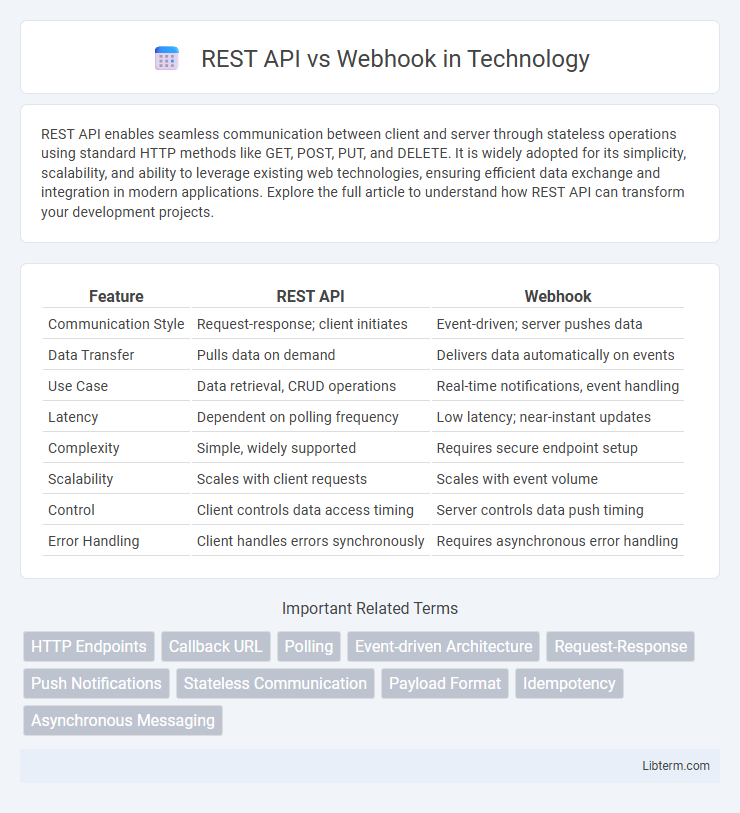REST API enables seamless communication between client and server through stateless operations using standard HTTP methods like GET, POST, PUT, and DELETE. It is widely adopted for its simplicity, scalability, and ability to leverage existing web technologies, ensuring efficient data exchange and integration in modern applications. Explore the full article to understand how REST API can transform your development projects.
Table of Comparison
| Feature | REST API | Webhook |
|---|---|---|
| Communication Style | Request-response; client initiates | Event-driven; server pushes data |
| Data Transfer | Pulls data on demand | Delivers data automatically on events |
| Use Case | Data retrieval, CRUD operations | Real-time notifications, event handling |
| Latency | Dependent on polling frequency | Low latency; near-instant updates |
| Complexity | Simple, widely supported | Requires secure endpoint setup |
| Scalability | Scales with client requests | Scales with event volume |
| Control | Client controls data access timing | Server controls data push timing |
| Error Handling | Client handles errors synchronously | Requires asynchronous error handling |
Introduction to REST API and Webhook
REST API is a set of rules and conventions for building and interacting with web services, enabling systems to communicate over HTTP by sending requests and receiving responses, typically using methods like GET, POST, PUT, and DELETE. A webhook is a user-defined HTTP callback that allows real-time data transfer by automatically sending an HTTP POST request to a specified URL when a particular event occurs. REST APIs facilitate synchronous, client-driven data exchange, while webhooks support asynchronous, event-driven communication for immediate notifications.
Key Differences Between REST API and Webhook
REST API operates on a request-response model where clients initiate calls to servers for data retrieval or manipulation, relying heavily on HTTP methods like GET, POST, PUT, and DELETE. Webhooks function as event-driven, push-based mechanisms that automatically send real-time data from a server to a client without continuous polling, triggered by specific events or changes. Key differences include REST API's synchronous client-initiated communication versus webhook's asynchronous server-initiated interaction, making webhooks efficient for timely updates while REST APIs provide controlled and on-demand data access.
How REST APIs Work
REST APIs operate through stateless client-server communication, where clients send HTTP requests such as GET, POST, PUT, or DELETE to access or modify resources on a server. Each REST API request contains all the necessary information, including authentication credentials and parameters, enabling the server to process and respond with the appropriate data or status codes. This interaction model allows for scalable, decoupled applications that rely on standard web protocols to perform synchronous data exchanges.
How Webhooks Function
Webhooks function by sending automated, real-time HTTP POST requests to a specified URL when a particular event occurs, eliminating the need for constant polling. They enable instant data transfer from the sender to the receiver, making them highly efficient for event-driven workflows. Unlike REST APIs that require client-initiated requests, webhooks operate through server-initiated notifications, ensuring timely and seamless integration between applications.
Use Cases for REST API
REST API is ideal for applications requiring real-time data retrieval and manipulation through standardized HTTP methods like GET, POST, PUT, and DELETE, commonly used in CRUD operations for database management, user authentication, and e-commerce transactions. It supports synchronous communication, enabling clients to request specific resources or perform actions on demand, which is essential in mobile apps, web services, and third-party integrations. REST APIs are also preferred when clients need to control the timing and frequency of data access, such as fetching updated user profiles, submitting forms, or managing cloud infrastructure resources.
Common Applications of Webhooks
Webhooks are commonly used in real-time data synchronization, enabling applications to instantly receive updates such as payment confirmations or inventory changes. They are essential in automating workflows across platforms like GitHub for push notifications or Slack for messaging alerts. Unlike REST APIs, which require continuous polling, webhooks reduce server load and improve efficiency by pushing data only when events occur.
Pros and Cons of REST API
REST API offers a flexible and standardized approach for client-server communication, enabling easy integration with various platforms through stateless operations and widespread support of HTTP methods like GET, POST, PUT, and DELETE. Pros include scalability, caching capabilities, and a uniform interface that simplifies development and maintenance, while cons involve increased latency due to client polling, potential over-fetching or under-fetching of data, and reliance on continuous request handling by clients. Compared to webhooks, REST APIs require active client requests to retrieve updates, which can lead to higher resource consumption and less efficient real-time data delivery.
Pros and Cons of Webhook
Webhooks enable real-time data delivery by pushing updates automatically to specified URLs, reducing the need for continuous polling, which saves bandwidth and improves efficiency. However, webhooks can be less reliable due to potential issues with security, retries, and delivery failures, requiring robust error handling and validation mechanisms. They also demand precise configuration and management, as misconfigured webhooks may cause data inconsistencies or expose sensitive endpoints to unauthorized access.
Choosing the Right Integration Method
Choosing between REST API and webhook integration depends on the specific requirements for data exchange and real-time communication. REST APIs allow for on-demand, client-initiated requests to access or modify resources, providing precise control over data retrieval and updates. Webhooks enable server-initiated notifications for event-driven workflows, reducing latency and minimizing the need for repeated polling in applications needing immediate data updates.
Conclusion: REST API vs Webhook – Which to Use?
Choosing between REST API and Webhook depends on the interaction pattern and real-time requirements of your application. REST APIs are ideal for on-demand data retrieval and actions initiated by the client, offering greater control over requests and responses. Webhooks excel in event-driven scenarios, providing instant notifications and reducing the need for continuous polling, making them efficient for real-time updates.
REST API Infographic

 libterm.com
libterm.com